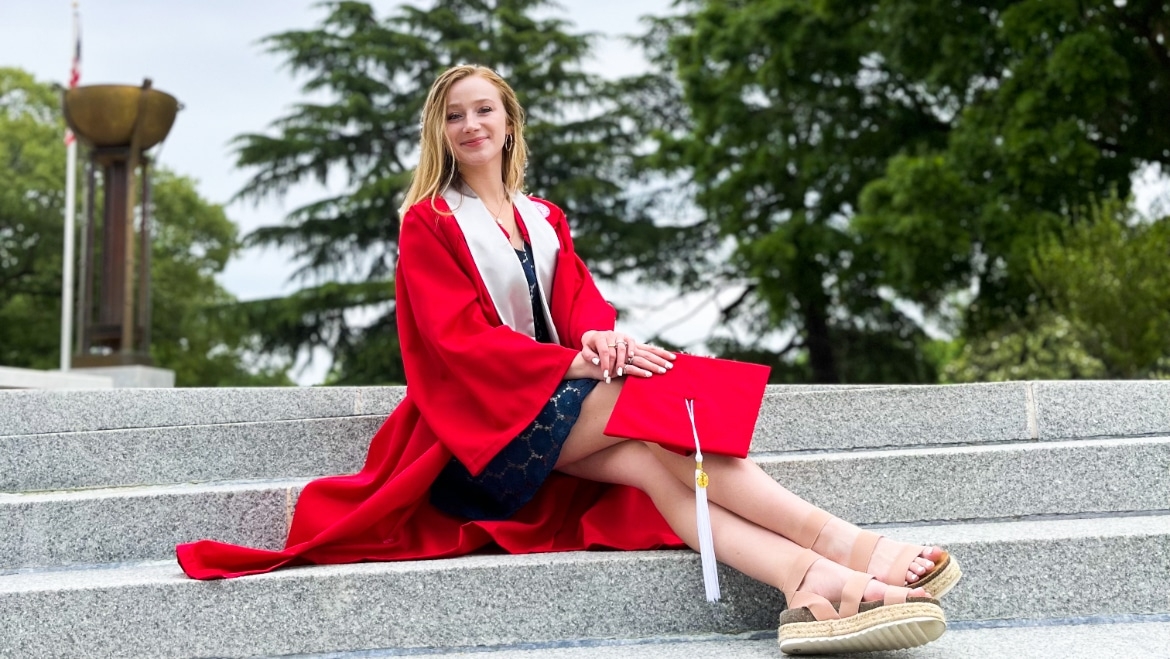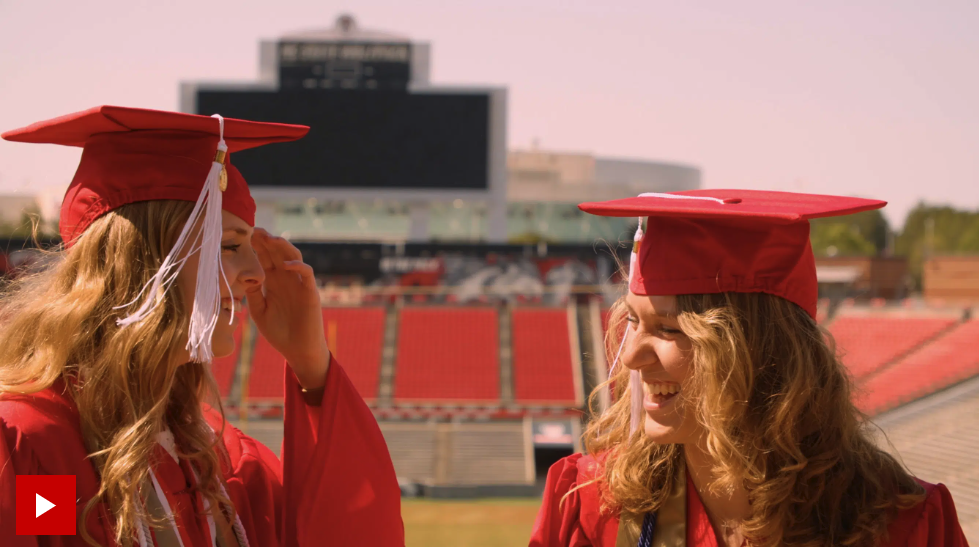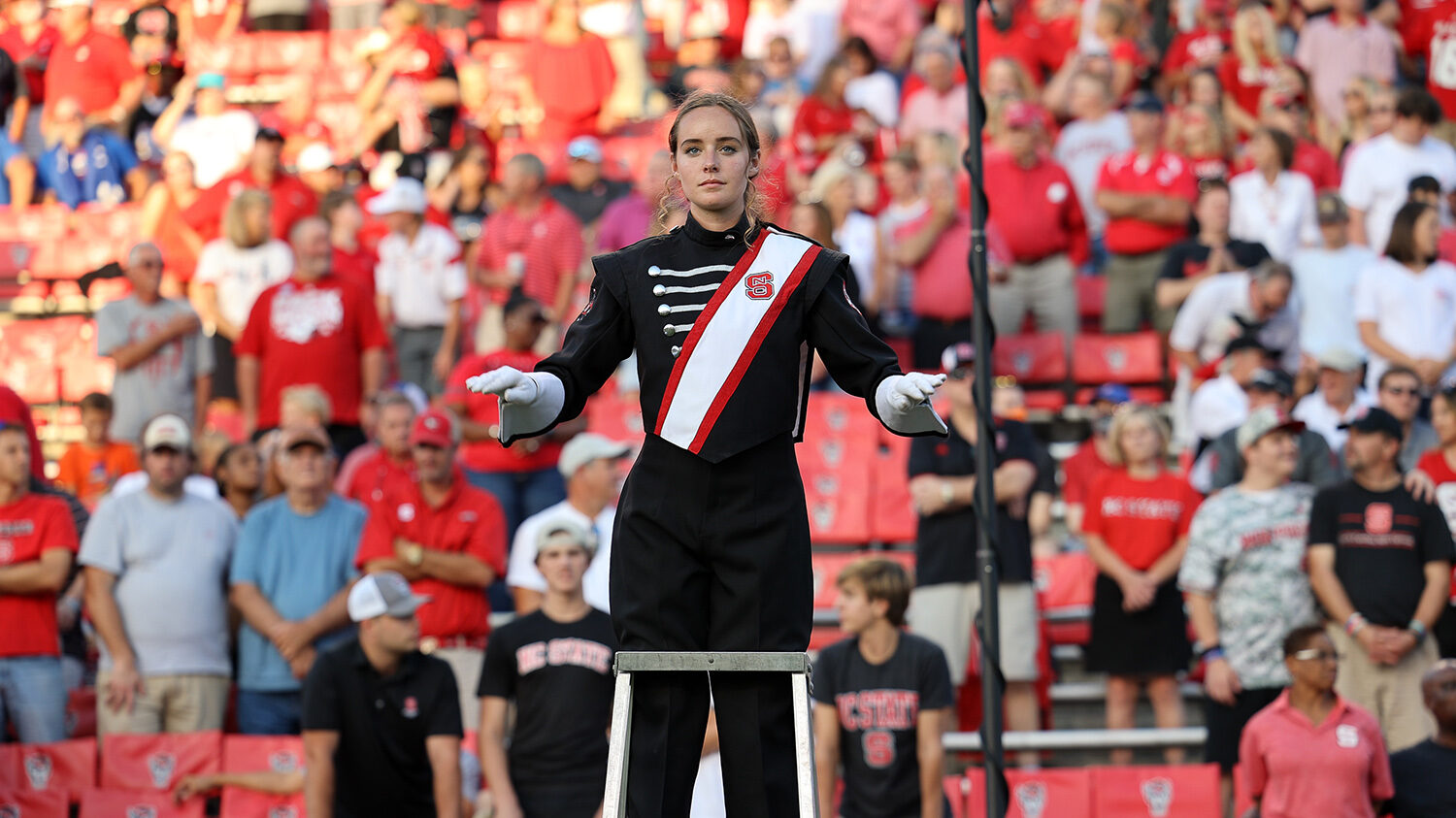Every note we play together is a win
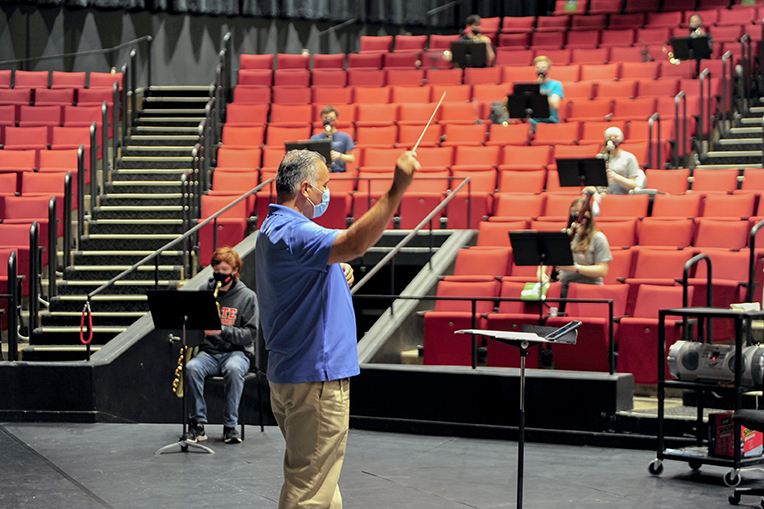
After nearly a year of online classes, faculty and students return to the rehearsal hall to make music together. With our COVID-19 mitigations in place, it doesn’t look the same. But it sounds triumphant.
It takes enormous teamwork, expense and creativity to teach and make music in an entirely new way, and that’s exactly the endeavor that the faculty, staff and students in the Department of Music undertook this year in response to the COVID-19 pandemic.
When classes moved online in March 2020, the department’s focus was simply on figuring out how to finish the semester remotely. Once it became clear that the pandemic wasn’t going away anytime soon, faculty and staff took a more proactive approach, spending the rest of spring and summer researching, planning and investing in what would be needed to teach safely and effectively in person or online as the situation dictated. In August, with students already on campus and just one week away from the arrival of protective equipment that would enable students to make music together, classes moved online again. This time, the department had plans in place that improved the experience for students, resulting in several inspiring projects that were completed remotely during the fall semester.
But recording yourself on your cell phone and seeing it edited together with similar recordings made by your fellow ensemble members is not the same as coming together in a room to make music as a band, orchestra or choir. Much of the community aspect of what musicians do has been out of reach for almost a year.
Fortunately, all the preparations the music department made over the summer of 2020 created a solid protocol that enabled student-musicians to return to campus for the spring semester of 2021. For the first time in over nine months, ensembles are rehearsing in person at NC State. But how exactly are they able to rehearse safely in the middle of a global pandemic?
Following the data
There are advantages to being a music department at a STEM-focused institution. One such advantage is the emphasis on and trust in research. When it became apparent that the coronavirus pandemic was going to impact NC State, Department of Music faculty and staff dove headfirst into the research—what data already existed and what data needed to be gathered? The challenge the department faced centered around the nature of playing wind instruments and singing, which both involve pushing air and moisture droplets out through the mouth. At this point, no one knew how the coronavirus was spread, but many viruses are spread through droplets, primarily released by coughing or sneezing, and it seemed likely that this one would be too. In March of 2020, professor and Department Head Dan Monek started looking for answers to the million dollar question—was it safe to rehearse and, if so, how could we make it happen?
“I don’t remember when the conversation started shifting to the risk of rehearsals, particularly choirs, but at some point the idea of super spreaders got picked up by the news; probably excessively so, in some ways,” said Monek. “Just as we teach our students, we began compiling information from everywhere we could. There was a little bit of information out there about singing and particle distribution because of research tied to other illnesses. Initially, however, there was nothing on wind instruments, but studies began to appear across Europe and then in the U.S. Everybody wanted to get classes and rehearsals back, but we didn’t know what was safe to do.”
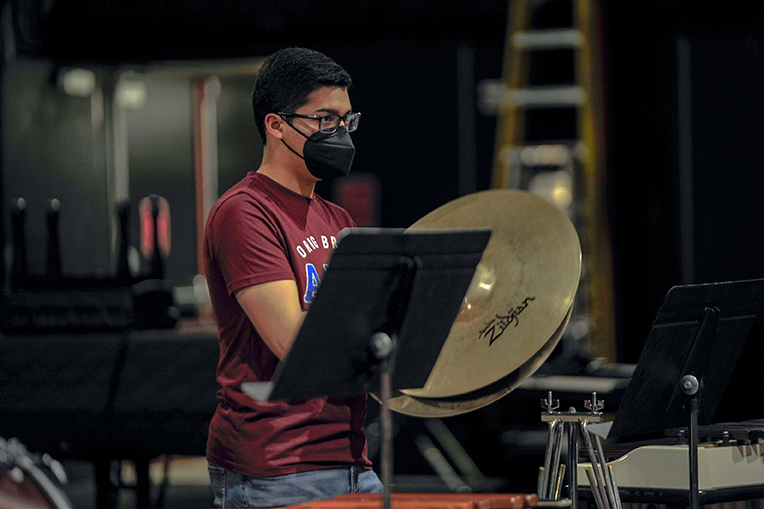
The first stroke of good luck for the department was that Paul Garcia, teaching professor and director of bands, had been elected president of the ACC Band Directors Association (ACCBDA) in December of 2019. In that role, he was contacted by a consortium spearheaded by the College Band Directors National Association and the National Federation of High Schools about a research study they were organizing to investigate the spread of the coronavirus through music making. The ACCBDA agreed to join with other organizations and universities to fund the study, which was conducted by virologists at the University of Colorado-Boulder and the University of Maryland. As a result, Garcia was invited to serve on the study committee, which gave the music department helpful context even before the study began generating results.
The study’s direction aligned with Monek’s initial hunch, that the virus seemed to be spreading through the air via aerosolization rather than through contact with droplets on surfaces.
“As we compiled information from studies, it became clear quickly that from the standpoint of music making this was going to be an aerosol issue,” said Monek. “Based on that we made the choice to focus our planning and energy on those aspects of mitigation. We decided early on that constructing complex arrangements of plexiglass barriers, as some music organizations were doing, would be expensive and less practical in providing a safe environment for music making. And I think because we didn’t waste a ton of money on this and focused our conversations around air quality in the rooms, we were better positioned to be ready to start in the fall.”
While the department was waiting for the results of the UC-Boulder study, Monek continued to monitor other studies and connected with NC State’s facilities and emergency management teams regarding the challenges that were unique to music making on campus, which led to studying the air exchange rates and flow in all of the department’s rooms to assess how long it would take for any contaminated air to be replaced. Emergency management connected him to other studies that also provided valuable resources and information, and Monek made time to attend presentations and learn as much as he could to inform decisions going forward.
Meanwhile, the study’s results weren’t always what the committee members expected to see. For example, many assumed that playing a flute or piccolo would have a higher risk of spread than a trumpet due to the fact that you blow across the opening rather than into it.
“We thought [with a flute] your air splits, you’re blowing freely. That’s going to be [the worst],” said Garcia. “But what we didn’t think about and the aerosolization specialists pointed out to us was when you play the flute there’s very little to no resistance, so the aerosols are not being pressurized and then put out like they would out of, say, a trumpet. Because when you play the trumpet…you have to use so much force with the air. You’ve got the buzz [of your lips] which is putting more aerosols into the air. So the spread can be very high for an instrument like that.”
Since other departments on campus were not facing the unique challenges that music-making presented, Monek decided to reach out to the heads of music programs at other universities and colleges in the state who he thought might be feeling similarly alone in the complexities of the situation they faced. They began meeting on Zoom in April, and met every two weeks throughout the summer to share information, resources and tips.
“That exchange of ideas helped formulate decisions,” said Monek. “People started exchanging ideas about what masks are you getting, where are you getting your masks, here’s a design of a mask—because no designs existed—should the instrumental mask have a slit that goes this way or a slit that goes this way, what works on different instruments and what was everybody trying. And this was happening in pockets all over the country, so I don’t think we were unique. I just think that we were attentive to the data as early as we could be, and then we got our own on-the-ground research about our facilities, and committed early to get equipment. We got lucky almost every time with that, because many items became difficult to acquire.”
As the data continued to trickle in, the department was able to begin making decisions and outlining a mitigation plan that would make it possible to rehearse safely. Based on the research, the music department ultimately decided to take a multi-layered approach which includes face coverings and bell covers, spaces with better air exchange, physical distancing, and shortened rehearsal times. With a mitigation plan in place, the idea of rehearsing safely in person started to feel possible. The department prepared to welcome student-musicians back to campus in the fall.
Rethinking what a rehearsal looks like…again
When students arrived on campus in August, the department was still awaiting the arrival of the face coverings and bell covers. The marching band could march but no wind instruments could be played. Just a few days before the mitigations arrived, the university announced the decision to move all classes online for the remainder of the semester. Monek and Garcia use words like “painful” and “gut-wrenching” to describe how it felt to be so close to making music together and not being able to do it.
Fortunately, once conditions improved and the option opened up for in-person spring classes, the department was able to welcome students back safely in January thanks to the extensive research and preparations done in the summer. In-person rehearsals are underway for several of the department’s ensembles, including the jazz bands, pep band and concert bands, and the choirs plan to begin rehearsing in person later this semester.
With all the mitigations in place, it’s not the same as a normal rehearsal. Physical distancing requirements limit the number of students who can rehearse in a given space and force nontraditional seating arrangements. Larger groups are rehearsing in Stewart Theatre, which normally seats up to 759 people. With the required physical distance between them, that 759-seat concert hall only holds 50 students. Due to the state and university regulations, end-of-semester concerts won’t be able to be held in person, which means faculty are still having to think outside the box about what their final course product will look like.
“You have to allow yourself to accept that we aren’t attempting to recreate our performance product in the way we did it before the pandemic, and that can be difficult,” said Monek. “Our faculty are super dedicated to this terrific final performance that they guide their students to produce all the time. Wrapping your head around the fact that that’s off the table in the current circumstances is a tough one.”
Getting the facilities ready for students to return fell largely on the shoulders of operations coordinator Colin Moore, who also assists ensemble directors with concert planning and, more than ever before, with recording projects. Even with students back on campus, Moore and the ensemble directors are finding ways to use technology to improve upon the types of projects they’re able to do with their students in lieu of concerts.
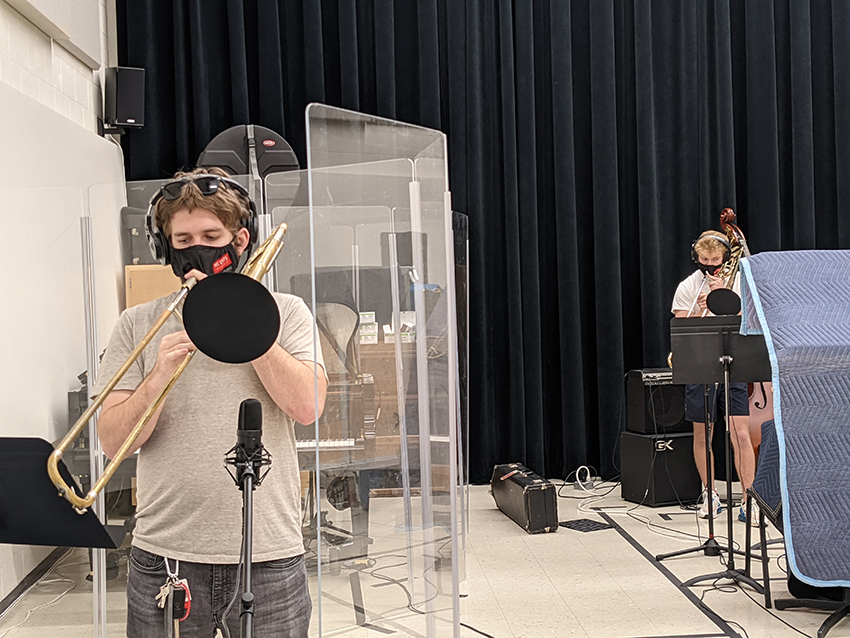
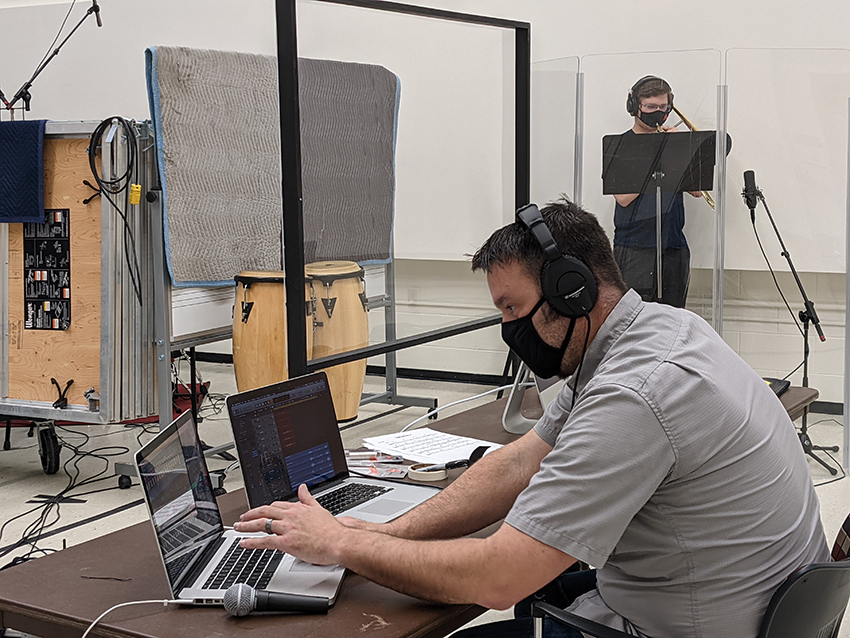
Teaching professor Wes Parker, director of jazz studies, runs a recording session with students in the Jazz Lab Band in February 2021. A variety of recording projects take the place of traditional end-of-semester concerts during the pandemic. Photos by Erin Zanders.
“Being able to record people in person [has] really greatly improved the quality both of the recording itself—because we have better equipment than [students] on their cell phones—and in the playing,” said Moore. “We’re figuring out how we use technology beyond just ‘let’s give a lecture on Zoom’, and really leveraging it to have a new target for a kind of project that we want to make.”
With these preparations and many more behind the scenes, the department was ready to bring the students in and start rehearsing, at least in theory.
“When we came back [in January], even with everything I know and knowing that other colleges did it safely all last semester, for those first 14 days at least once a day I thought, ‘Are we going to shut down a rehearsal? Is this enough? Did we do enough?’” said Monek.
Bringing music back to campus
The good news is that the mitigations appear to be working, paired with the university’s required weekly testing policy and contact tracing program which identify and isolate cases of COVID-19 quickly. Rehearsals have been underway since students returned in January and there have been no outbreaks in classrooms.
Every ensemble director is taking a different approach to rehearsing, with some electing to stay online for all or part of the semester. The concert bands, jazz ensembles and pep band are meeting in person several times each week, in different configurations.
Lecturer Chris Branam, who conducts the symphonic band, typically has close to 100 students in his band. This semester, with many students electing to stick to online classes, he has 50 students which works perfectly with the reduced capacity of Stewart Theatre. Ensembles are limited to 45 minutes of playing time, with required down time between rehearsals for air exchange.
During rehearsals, Branam and his percussion section are positioned on the stage facing the other students who sit in the tiered audience seating, spaced at least six feet apart from one another.
“That creates a lot of problems because of directional instruments, meaning a trumpet plays and the bell of the instrument, the sound goes out that way,” said Branam, “whereas a clarinet, when you play into it, the sound goes out of all the tone holes. There’s a different venting process. So being able to move the students around to where you can get a better mix has been a huge challenge because it’s not the typical concert band setting where you’re close and you’re able to hear each other in a real intimate way. [Normally] you can hear everybody in your section take a breath. You can hear a section across the band play a counter melody, or you’re tuning towards that bass note that sits behind you. That’s not happening this semester, because you’re so far apart the connection is so difficult to make. That’s one of the big challenges that we’ve had.”
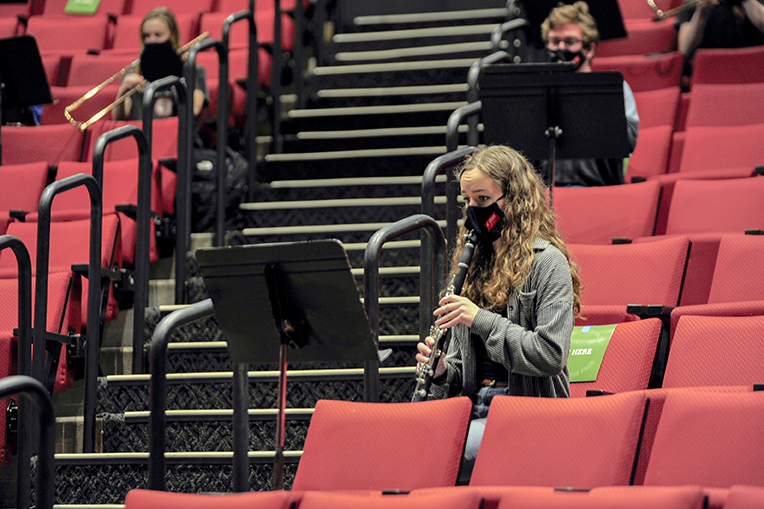
Clarinetist Laura Dugan rehearses with the wind ensemble in March 2021 in Stewart Theatre. Photo by Erin Zanders.
The other big challenge is the reduced class time, which limits the amount of material an ensemble can cover each week. But all of the limitations of the COVID-19 mitigations also have practical applications from a teaching perspective that may benefit the ensembles in the long-run.
“These are regular pedagogical things that make us better conductors,” said Monek. “Time is your enemy. There are studies out there that show a lot of conductors spend a lot of time talking. And with students there’s a lot of chit chat and you lose ten seconds here, five seconds there, and it adds up over time. Some of that’s about the social aspects of what we do, and that’s not bad, so I’m not necessarily saying it should all go away. But when you have to really focus your time it makes you a better rehearsal technician and makes you a better ensemble member because you have to respond efficiently in that time.
“Being distanced makes you listen better, makes you more aware. It’s not an unusual pedagogical tool for some music educators to spread people out. It makes everybody watch more. The sound is traveling to you differently, so the visual of the conductor and that form of communication becomes much more important. When you have to do anything in really difficult circumstances and then you come back and do it in more ideal circumstances, I think most of the time you’re better for that. You will approach the ideal circumstance differently. You’re going to take some of that skill back with you.”
Each ensemble also has a different plan for presenting a final product in lieu of their traditional concert. Wes Parker’s jazz ensembles are recording in sections in what Moore calls a “conceptually duct-taped” recording studio setup that he and Parker pulled together using equipment they had on hand in the fall. This semester they’ve expanded to utilize two rehearsal rooms in Price, new mics, a lot of cables and plexiglass drum shields. Parker and his students were already producing remarkable recordings using the original setup and it gets better with each new piece of equipment the department is able to purchase. The ability for ensembles to produce quality recordings in house creates new opportunities for learning, beyond the pandemic.
For Branam’s symphonic band, he plans to record each piece of music as they learn it, recording sections separately in Stewart Theatre. He hopes a livestreamed concert will be possible, but if not they’ll have recordings ready to share. For Garcia’s wind ensemble, they are recording the full band one piece at a time, and plan to either release them online as individual pieces or as a YouTube premiere event later in the spring.
Reconnecting to what we love
It cannot be overstated how much joy the return to in-person rehearsals has brought to students, faculty and staff alike in the music department.
“The [music department] community has been my main community since coming to college. I’ve bonded with the other students in marching band, pep band and symphonic band every year,” said Miranda Smith, Business Administration and Economics, ‘22. “I think connections in this department are unique because everyone is in different majors and has completely different backgrounds…Since COVID-19, this large community has felt further and further away.
“Additionally, I’ve been playing the trumpet since I was ten years old,” Smith added. “I love having an opportunity to come back and partake in the creation of music with people I enjoy spending time with. It truly is a pleasure to get back in the habit of playing.”
For Branam, who has taught at all levels, K-12 and college, being disconnected from his students for so long was tough.
“It’s been 30 years that I’ve been teaching and interacting with students, and when that’s just gone and it goes to a sterile place of the internet…when you lose that it’s like losing part of what you are, and what you do, and the essence for why you do what you do,” Branam said. “It’s so precious that you have that time together, and I think that’s what makes it so great to be back because that [part of you] now is back, and we can make those musical moments together.”
For Garcia, who came the closest to rehearsing with the marching band before classes moved online in August, it was especially difficult to let that go because he knew from his involvement in the UC-Boulder study that rehearsing could be done safely. But the moment that will always stick with him is the first time the wind ensemble played a note together, in person, this spring.
“We played a B flat concert pitch. The simplest thing,” he said. “We played this B flat concert and I cut off, and I had to take a moment because I was choked up. I was emotionally moved, almost to tears. I really had to fight them back for a moment, just because of what it took to get back to that moment, to actually make a sound together…Even though they’re masked I can still see their eyes and the focus, the creativity, the joy, the sorrow, the happiness, so many things that they can get from being together and making music. So as simple as that B flat was, the power of the emotion in that moment, I cannot put into words, really. But just the feeling of that, I’ll never forget it, because of what an accomplishment it was to get to that point.”
With all of the challenges and setbacks, Monek is able to see some positives that have come out of the constant rolling changes the department has had to make this year, like learning new ways to use technology in teaching music. One major positive for the department has been seeing how dedicated the student-musicians of NC State are to their music, their ensembles and their student organizations.
“It shouldn’t go unsaid that it’s been pretty dramatic how the students at NC State have stayed committed to music,” said Monek. “It would have been really easy to say, ‘This online ensemble thing, I can’t deal with it. I’m gone.’ And I’m sure there are students that made that choice, and I think that’s perfectly okay. That’s a good choice. You have to make good choices for you…But I think that a lot of them really stuck it out, even though it was way harder and they didn’t need to. We’re not a school of music with students who need these courses for their major. Every course we teach is optional for our students. So they just didn’t need to do it, and the fact that they stayed and stayed committed to us and to each other is huge.”
To learn more about how the department adapted to teach music online back in the fall, check out the article from the fall 2020 email issue of Wolf Tones.
- Categories:
